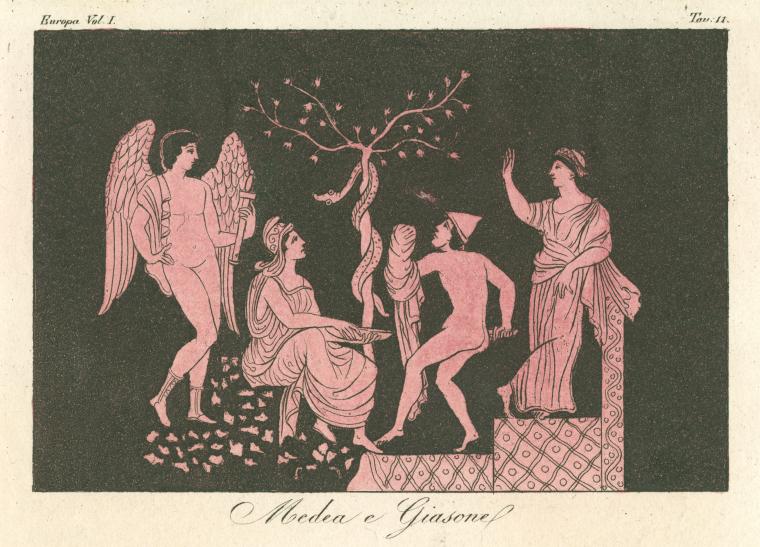Reader’s Den
Reader's Den November - Hell Hath No Fury: Gone Girl, Medea, and the Allure of the Femme Fatale, Part 2
Both Gone Girl and Medea feature two classic examples of the Femme Fatale archetype. In this installment of the Reader's Den, we will examine the appearance of the vengeful female or femme fatale as portrayed in film.
Medea was originally conceived of as a play by Euripides, and first staged in 431 BC at a festival held in Athens honoring the Greek God Dionysus (it took a third place prize). Throughout the ages, differing civilizations have had different reactions to Medea's theme of taking justice into one's own hand in an unjust society, Amy Dunne's 'taking matters into her own hands' probably is less defensible ; although the book and film versions of Gone Girl offer a scathing critique of how the media can exert powerful influence over the justice system.
On screen there have been several interesting interpretations of the Medea story, notably iconoclastic Italian director Pier Paolo Pasolini's Medea (1969) starring opera diva Maria Callas in the title role. With stunning scenes shot in Turkey, a sparse haunting score and dazzling costume design, Pasolini's interpretation focuses attention on class division, through the contrast of life on Colchis and in Greece. Lars von Trier, the iconoclastic Danish director, made a stark and violent version of Medea (1988) for Danish television, starring Udo Kier as Jason.
A femme fatale is defined as: an attractive and seductive woman, especially one who will ultimately bring disaster to a man who becomes involved with her. Let's have some fun with our femme fatale's through the lens of film.
Film Noir of the 1940s were rife with femme fatale archetypes. Film scholars posit that because the role of women in society changed so dramatically during and after WWII in the United States, Hollywood started paying more attention to casting strong starring female characters. Some classic femme fatales on film include Jane Greer in Out of the Past. In Dark Passage , Humphrey Bogart finds himself in a situation similar to Nick Dunne, falsely accused of his wife's murder, aided by Lauren Bacall to help solve the mystery. Barbara Stanwyck plots her husband's demise in Double Indemnity, as does Lana Turner with a drifter she meets at her husband's gas station in The Postman Always Rings Twice.
The 1960s and '70s were the height of the women's liberation movement, and a change in the portayal of womens' roles on film came about as a result. Faye Dunaway shines as gun toting Bonnie Parker to Warren Beatty's Mr. Clyde in Bonnie and Clyde, while her performance as the calculating Ms. Mulwray in Chinatown harkens back to the '40s Noir era. Pam Grier's unforgettable performances in Coffy and Foxy Brown epitomizes the female vigilante within a socially critical urban framework. And Anne Bancroft's Ms. Robinson seduces unwitting Dustin Hoffman in The Graduate before he knows what hits him.
Kathleen Turner Certainly no viewer can remain unscathed by the potboiler concocted by jilted lover Glenn Close in Fatal Attraction. Director Paul Verhoeven visits this theme in Basic Instinct with Sharon Stone, Nicole Kidman exploits a student in Gus Van Sant's To Die For. Sean Young pulls the wool over Harrison Ford in Bladerunner. One of Abel Ferrara's earliest films, Ms. 45, concerns a young, mute seamstress in New York exacting some revenge after becoming the victim of street crime. Isabella Rosallini plays a mysterious night club singer in David Lynch's Blue Velvet. A widower gets drawn into a web of confusion with a young woman who pretends to be trying out for his film in Audition, and who can forget the trail of blood and tears left behind by Uma Thurman in Kill Bill.
Everyone's got their favorite femme fatale: Readers—let us know who YOUR favorite femme fatale in film or fiction is!
Thank you for reading November in the Reader's Den!
We'll be back next month in the Reader's Den with The Coming of Conan the Cimmarian by Robert E. Howard, illustrated by Mark Schultz.
Read E-Books with SimplyE
 With your library card, it's easier than ever to choose from more than 300,000 e-books on SimplyE, The New York Public Library's free e-reader app. Gain access to digital resources for all ages, including e-books, audiobooks, databases, and more.
With your library card, it's easier than ever to choose from more than 300,000 e-books on SimplyE, The New York Public Library's free e-reader app. Gain access to digital resources for all ages, including e-books, audiobooks, databases, and more.
If you don’t have an NYPL library card, New York State residents can apply for a digital card online or through SimplyE (available on the App Store or Google Play).
Need more help? Read our guide to using SimplyE.
